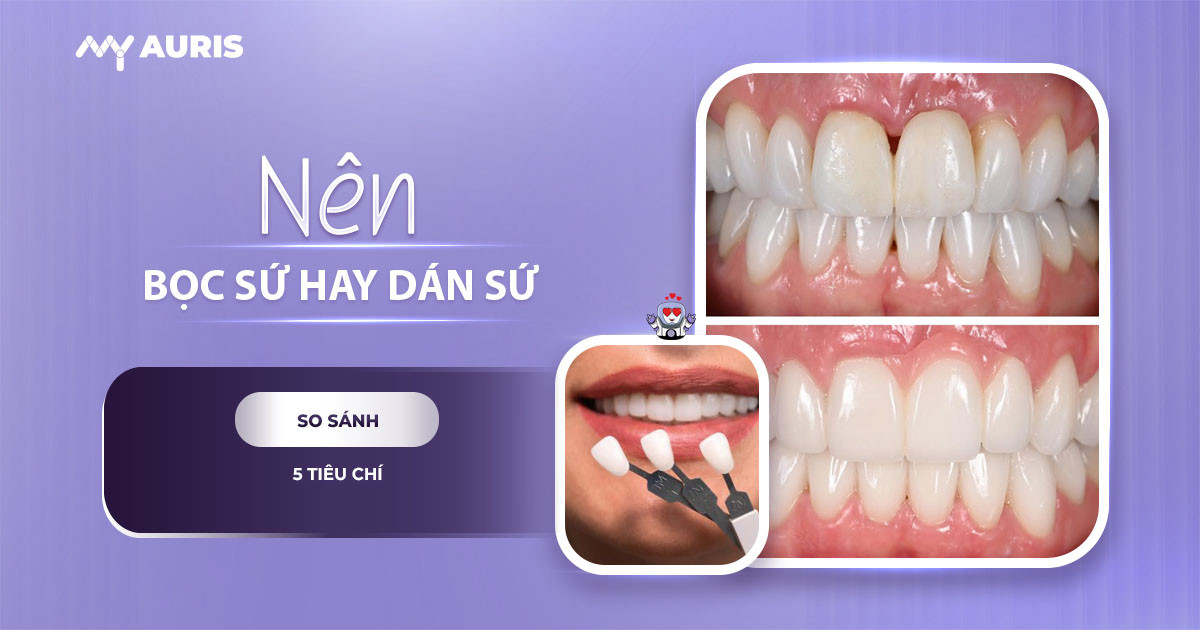Porcelain crowns and porcelain veneers are two solutions to improve the aesthetic appeal of teeth, helping to create even, bright white smiles. However, they differ in structure, application technique, aesthetics, and indications. Let’s explore them in detail to choose the most suitable option!
The difference between porcelain veneers and porcelain crowns
In cosmetic dentistry, porcelain veneers and porcelain crowns are two popular methods to improve smiles. Each technique has distinct differences in technical characteristics, durability, restorative materials, cost, and suitable application cases.
- Technical characteristics
Porcelain veneers: The dentist only grinds a thin layer off the outer surface of the tooth; in some cases, no tooth preparation is needed. Then, a thin porcelain piece (0.3 – 0.5mm) is bonded to the tooth surface, helping to conceal defects in tooth shape or color, such as discolored teeth, minor gaps, chips, or worn enamel.
Porcelain crowns: The dentist needs to grind down a significant portion of the natural tooth structure to create an abutment, after which a porcelain crown is placed over it to restore its shape, function, and aesthetics. However, this method is more invasive than veneers.

- Material and restoration thickness
Porcelain veneers: Made from 100% high-quality porcelain, with a thickness of only 0.3 – 0.5mm, they still fit snugly around the tooth, providing high aesthetic appeal and a natural look. Because they are so thin, procedures such as tooth preparation, impression taking, model replication, laboratory fabrication, bonding, and polishing must be performed precisely and skillfully.
Porcelain crowns: Crowns can be made from porcelain-fused-to-metal or all-ceramic, with a thicker structure (0.6 – 2mm). They are designed to mimic the shape, size, and color of natural teeth, with a hollow interior to fit over the prepared tooth abutment.
- Restoration durability
Both methods offer high restoration durability, lasting from 8 to 10 years, depending on oral hygiene, the dentist’s skill, restorative materials, and execution at a reputable dental clinic.
- Applicable cases
Porcelain veneers are suitable for teeth with mild discoloration, minor gaps, small chips, or enamel erosion over time.
Porcelain crowns are preferred for extensively fractured teeth, teeth that have undergone root canal treatment, severely decayed teeth, teeth with major aesthetic defects, or even minor rotations of a single tooth, or when a dental bridge is needed.
- Cost of procedure
Porcelain veneer cost: Ranges from 8,000,000 – 10,000,000 VND per tooth, which is higher due to the complex veneer bonding process, better preservation of natural tooth structure, high demands on the dentist’s skill, and modern equipment.
Porcelain crown cost: Lower, ranging from 5,000,000 – 8,000,000 VND per tooth (for all-ceramic crowns), making it suitable for a wider range of patients.
Overview comparison table between porcelain veneers and porcelain crowns
| Criteria | Porcelain Veneers | Porcelain Crowns |
| Technical characteristics | Grinds a thin layer off the outer surface of the tooth | Grinds a significant portion of natural tooth to create an abutment |
| Restoration thickness | 0.3 – 0.5 mm | 0.6 – 2 mm |
| Material | 100% high-quality porcelain | All-ceramic or porcelain-fused-to-metal |
| Purpose | Conceals defects: mild discoloration, uneven tooth size, minor gaps, small chips, worn enamel | Restores: extensively fractured teeth, severe decay, root canal treated teeth, major aesthetic defects |
| Durability | 8 – 10 years (with good care and proper technique) | Comparable to veneers |
| Reference cost | 8,000,000 – 10,000,000 VND/tooth | 5,000,000 – 8,000,000 VND/tooth |
Similarities between porcelain veneers and porcelain crowns
It’s no coincidence that porcelain veneers and porcelain crowns have become popular choices. Let’s explore the outstanding advantages that make these two techniques highly regarded.
- High aesthetic appeal, effective improvement of tooth imperfections
Both methods significantly improve tooth imperfections such as chips, yellowness, and discoloration. After the procedure, you will have a set of uniformly white, naturally bright teeth, feeling more confident with every smile.
- Absolute safety, no oral irritation
If performed at a reputable dental clinic with assured materials, both porcelain veneers and porcelain crowns do not cause oral irritation, ensuring safety for oral health. You can eat comfortably and naturally, and use them long-term without worrying about black lines at the gum margins.
- Stable chewing ability, improved pronunciation
People with dental issues often experience impaired chewing function. Fortunately, both methods can resolve chewing problems, allowing you to eat comfortably with various foods. Additionally, even teeth and a correct bite also improve pronunciation, reducing hesitation and self-consciousness during communication.
- Long-lasting durability, long-term cost savings
With a lifespan of 10–20 years, depending on the type of porcelain and maintenance, both methods offer long-lasting durability. This helps you save significant costs in oral care over time. To ensure maximum effectiveness, careful selection of material quality is essential, as it is a crucial factor determining the lifespan of dental restorations.

Should You Get Porcelain Veneers or Porcelain Crowns?
When looking to improve their smile and address tooth imperfections, many people often wonder whether porcelain veneers or porcelain crowns are better. Both methods help restore flawed teeth and bring aesthetic beauty to the dentition. However, they have distinct differences: porcelain crowns rebuild severely damaged teeth, while porcelain veneers are more effective for aesthetic issues on intact teeth.
The choice between veneers and crowns cannot be universally decided for all cases. The effectiveness of each solution depends on various factors such as tooth condition, chewing habits, and the patient’s needs. Therefore, it is crucial to select the option that is most suitable for each individual.
Patients should visit a reputable dental clinic with a team of skilled dentists for a comprehensive check-up and specific consultation. Typically, dentists recommend:
- Porcelain crowns for cases of severe tooth damage, requiring restoration of both function and aesthetics.
- Porcelain veneers for cases where the primary goal is cosmetic improvement and the teeth are still healthy.

Regardless of the chosen method, you should always have the procedure performed at a reputable facility with modern equipment and experienced dentists. If done at a low-quality clinic with inexperienced dentists, potential risks include:
- Grinding the tooth down to the pulp
- Poorly fitted porcelain crowns
- Causing complications such as: bad breath, bleeding gums, gingivitis
In summary, the choice between porcelain veneers and porcelain crowns should be determined based on a comprehensive assessment by a dentist. Do not rush to achieve a quick aesthetic result by skipping the examination and consultation phase. Entrust your oral health to reputable dentists to achieve a radiant and long-lasting smile safely.





